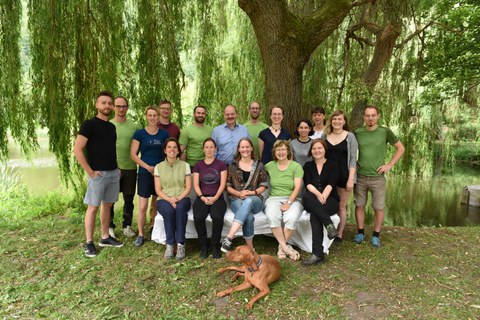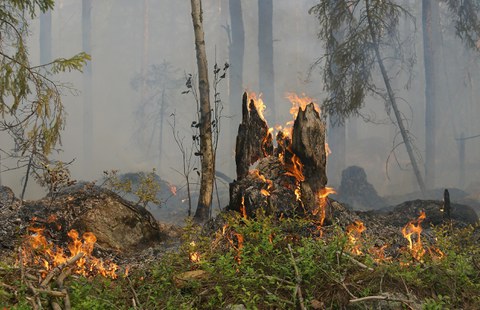Jul 30, 2022
TUD forest expert on the forest fire situation in Saxony and Brandenburg and demands for dealing with the danger of forest fires
Michael Müller, Professor of Forest Protection and Silviculture at the TU Dresden, has been involved with the topic of forest fires since childhood. He grew up in the Lusatia in the 1960s and 1970s in the areas particularly affected by forest fires and was a forest apprentice and forest worker there. Forest fires have been part of his teaching and research in forest sciences at the TU Dresden since 1999.

Team at the Chair of Forest Protection and Silviculture
"It is clear that forest fires are of no importance in the natural development of forest ecosystems in Germany. As in the case of the current fires in Brandenburg and Bohemian and Saxon Switzerland, they are almost always man-made, mostly by arson, sometimes as a result of human technologies. This also makes it clear that it is important to improve prevention and extinguish the fires as quickly as possible."
We have the knowledge and skills to do so.
The number of forest fires and forest fire areas has been steadily declining since the 1970s. This is due to the forest structures, e.g., the forest conversion that has been going on for more than 30 years and aging forests, despite the partly increasing risk of forest fires. However, we have some particular problem areas. These are areas contaminated with munitions, especially in so-called wilderness areas, inaccessible post-mining areas, areas with particular fuel inputs (e.g. coal dust), and mountainous areas that are difficult to access with increased amounts of fuel. Almost all major fires (> 10 hectares) have occurred in such areas in the last 30 years.
Germany is a world leader in surveillance: forest fires are usually discovered within ten minutes. The first emergency services are usually on-site within 15 minutes of the alarm being raised. We also have the necessary knowledge for forest fire prevention and fighting. We have over 99 percent of forest fires under control within the first two hours after the alarm is raised - in Brandenburg forests alone there are an average of 500 to 600 fires per year and only in the rarest of cases do fires spread to the extent that we are currently experiencing.
The problem with fires like the current forest fire in Brandenburg is that they take place in areas contaminated with ammunition and must not be extinguished there. There is an urgent need to invest in the development of ground-based, autonomous extinguishing systems that make it possible to extinguish without people being on site. In addition, extinguishing with water requires the supply of very large amounts of water. What matters here is the availability of extinguishing water in a narrow distribution and large quantities as well as the efficiency of the water use. An alternative that I would like to investigate and help develop is to be able to deposit environmentally friendly foams as foam barriers that are effective for several hours.
In addition, there are currently fires in protected areas, i.e. in forests where our society has decided not to intervene and to forgo effective forest fire prevention. This position should be reconsidered. Strips 35 to 50 meters wide, reducing the fire load and creating infrastructure such as deep limbing and removing fuel on the ground, are sufficient to prevent the vertical spread of fires, enforce well-fightable ground fires and wound strips and create access routes for the firefighters.
If you do not want this within these areas, you should be consistent enough to accept these dangers, risks and consequences of fire in the future and only secure the edges of cultural areas so well that the fires do not cross the borders of the areas that are then also to be completely closed and, if necessary, protected. cannot overcome areas to be vacated. I am expressly not of this opinion and the state of knowledge also contradicts this approach. However, if society does not want to meet the requirements for successful fire prevention and firefighting in these areas because other goals have higher priority, one should no longer spend money on firefighting in these areas and not bind the comrades of the fire brigades there unnecessarily or even put in danger.
Forest fires in Germany not only damage the forest itself, but also the environment and people. With every fire, huge amounts of plants, animals and fungi are killed in an unnatural way, and greenhouse gases, fine dust and toxins are released. This is one of the reasons why methods of preventive burning to reduce the fire load or maintenance measures by using fire in forests are not compatible with the concerns of near-natural forest management, nature conservation and climate protection. Only the use of advance or return fire in forest firefighting situations that cannot be solved in any other way would be acceptable but must be handled professionally. We currently have to adapt to the situation and learn to live with it. We need more specialists, better equip research and development, reduce the hurdles to implementing preventive measures and make the fire brigades even better equipped to fight forest fires.
There are several research and development projects on forest fires at the TU Dresden. At the professorship for forest protection and silviculture, we develop forest fire protection concepts for eleven particularly endangered forest areas in five German federal states in the projects "THOR - sub-project 2" and "HarzWB". However, it can sometimes take several years before these concepts are approved and implemented, during which time the forest also changes significantly.
Last but not least, the forest owners must be in a position to make informed decisions about forest fire prevention and how to deal with forest fire areas, and to follow these up and finance them. I advocate that options are created here that reward a near-natural, adaptable but possibly also fire-retardant forest. This is mostly not the case. Currently, the only significant source of income for forest owners is timber. Income from the provision of other forest services such as nature conservation or recreation is prohibited, as are other forest products such as berries or mushrooms. It is therefore imperative that forest owners attach great importance to the timber yield, despite their willingness to provide other forest services. Here, other payment systems – I am not talking about subsidies or compensation – would help to use the commitment of forest owners in largely self-regulating systems for the forests of the future.
However, many of the options just mentioned are very difficult to implement in an area like Saxon Switzerland. Here we have a special situation anyway due to the national park, the poor accessibility and the sandstone. It is to be feared that the lack of vegetation and soil cover will lead to increased erosion, e.g. during heavy rain events, soil and wood move through water, rocks may loosen. Just as forest fire areas have to be secured in the lowlands, conclusions would also be drawn in the Elbe Sandstone Mountains to draw for follow-up action. In the valleys, for example, little deadwood should be left near the river. Geoscientists, hydrologists and mountain specialists can help verify the safety of trails, streams and rocks in the fire area. It's a national park. The evolution of ecosystems restarts after this extreme and homogenizing human intervention. We are breaking new ground here. There is no scientific precedent for such a situation in the Elbe Sandstone Mountains, nor is there any experience on this scale of concern.”
Contact:
Prof. Dr. Michael Müller
Chair of Forest Protection and Silviculture
Technische Universität Dresden
+49-351-463-31280
Email:
tu-dresden.de/bu/umwelt/forst/wb/waldschutz

